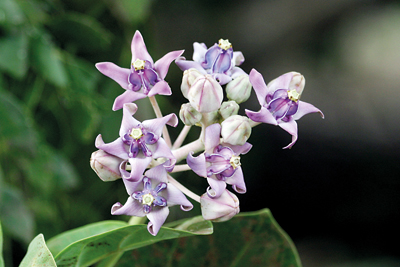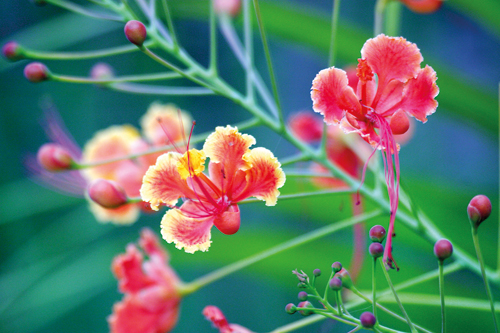A little guide to open up interest in local blooms

Wara Calotropis gigantea
“A Naturalist’s Guide to the Flowers of Sri Lanka” written and illustrated by co-authors, Gehan de Silva Wijeyratne, Darshani Singhalage and Nadeera Weerasinghe has been released recently.
The fourth Naturalist Guide to be published on Sri Lanka by British publishers John Beauufoy Publishing, this book is targeted at “people like me” Gehan is quoted as stating as many struggle with identifying the country’s array of flora, some of which are endemic to Sri Lanka.
“The book is a result of 20 years of hard work,” Dharshani shares adding that capturing images of some flowers had to be strategically planned as they bloom at certain times/ seasons. The scientific names of the different plants have been given and where possible their English, Sinhalese and Tamil names. Each species is represented by high quality images and description on plant identification, distribution, habitats and flowering period with further information available on plant families, reproduction, biology, taxonomy, field sites and references.
The idea of “A Naturalist’s Guide to the Fflowers of Sri Lanka” was first suggested by Gehan to Nadeera in the early 2000s when Nadeera was working as a naturalist at the former Jetwing Yala Safari Game Lodge. However, the devastating 2004 tsunami destroyed the lodge and with it Nadeera’s notes and images making them abandon all thoughts of the publication.

Caesalpinia pulcherrima. (Pix by Gehan de Silva Wijeyeratne
However the idea re-emerged as the years went by as Gehan urged his friend to improve his botanical knowledge. “He seemed to have taken this suggestion very seriously as he married a botanist!” Gehan adds.
In 2008, along with Nadeera’s wife Darshani Singhalage, the trio resurrected their plans. Nadeera and Gehan set out to capture pictures for the guide and with plant identification being carried out by Nadeera and Darshani with assistance from Professor Siril Wijesundara; the pictorial guide was slowly but surely taking form.
Dharshani has a PhD in multi microbial biofilms and their benefits in plant growth promotion. A senior lecturer at the Uva Wellassa university, Badulla, she has over 20 years of experience in studying wildflowers endemic to the island.
“The book is useful for students and academics and tourists who want to learn more about Sri Lanka’s flora,” Dharshani says.
Although Gehan’s migration to the UK in 2010 and Nadeera and Dharshani starting a family delayed the final publication, the authors never lost sight of the need in the market for this particular pictorial pocket book.
With roughly over 4,143 species of flowering plants recorded to date this bite sized guide covers 209 species using close to 350 images and further explores plant families and their interrelationship.
“In one way or another the pocket photographic guide derives inspiration from the many Sri Lankan botanical books that precede it,” Gehan states.
Dharshani further adds, “We mainly focused on selecting wild flower species because this area is not touched in many books and most of them are rare and only present in remote locations and usually difficult to reach areas.”
The research for the guide was carried out over an extensive field range from areas such as the mountain forest zone (eg. Horton Plains National Park, Knuckles Forest Reserve, etc.), the wet zone (eg. Sinharaja Forest Reserve), dry zone locations (eg. Yala National Park, Sigiriya, Dambulla, etc.) seashore habitats and in addition around Buddhist temples, the Peradeniya Botanical Gardens, public roads and home gardens.
Written in simple English, with no emphasis on technical jargon, the book aims to be an affordable and portable field guide to the flowers of Ceylon as all flowers are arranged based on a taxonomic order classified by molecular phylogenetics (a system known as APG4).
Looking to elevate the country’s understanding and knowledge about the flowering plants endemic to Sri Lanka, Gehan can only hope that by reading the pictorial guide it will help more people to take a serious interest in botany and develop the confidence to immerse themselves in more technical and comprehensive botanical literature in the country in the future.
“A Naturalist’s Guide to the Flowers of
Sri Lanka” is currently available at
Vijitha Yapa bookshops islandwide
priced at Rs. 1,750.


